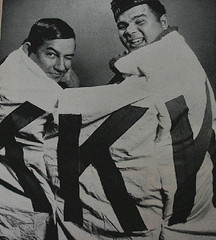Double Voting: A Personal Account
"'Double Voting' in Robeson County: A Reminder of an Unequal Past"
by Bruce Barton
Reprinted with permission from the Tar Heel Junior Historian. Fall 2004.
Tar Heel Junior Historian Association, NC Museum of History
Related Entries: Lumbee Indian Rights;
Double Voting in Robeson County before 1975
I remember well the time before the federal courts outlawed the evil practice of double voting. Back then in Robeson County, some people had two votes, and others had only one. Before 1975, six school systems existed in Robeson County. They were Lumberton, St. Pauls, Fairmont, Maxton, and Red Springs (each of these towns had its own school system), and the Public Schools of Robeson County, which included everyone else. So people who lived within the town limits of Lumberton, Maxton, St. Pauls, Red Springs, and Fairmont had two votes for board of education members. They voted on the makeup of their own boards of education, as well as the board of education for the rest of the county (the Robeson County schools). But the residents served by the county school system each had only one vote. That part of the county’s population was 60 percent Indian, 20 percent African American, and 20 percent white.
I remember double voting as “the most evil political system ever devised by man,” as one prominent Lumbee Indian educator said at the time. The first article I ever wrote for the newspaper Carolina Indian Voice, a weekly publication based in Pembroke, was entitled simply “Double Vote?” Many columns on the nefarious practice of double voting appeared in the publication before the federal courts outlawed the unfair scheme. The practice basically kept many people of color out of positions of power in the
County school system, because the rural Indian and black residents were not able to overcome the double vote of the mostly white voters within the towns. The white voters usually elected white people to public offices, including the county school board. Often the white members elected to the county school board actually lived in the towns, where their children went to school, yet they controlled the county’s rural schools. It was a strange situation indeed!
Double Voting Broken
By the mid-1970s, the question “Have you heard from the lawsuit to break ‘double voting’?” had become a form of greeting between Indians and their friends in Robeson County. And there the matter rested until April 23, 1975, when the United States Court of Appeals for the Fourth Circuit, sitting in Richmond, Virginia, changed the situation resoundingly by ruling that double voting was unconstitutional because it essentially diluted the votes of the residents of the Robeson County school administrative unit. District court judge Algernon Butler, in the Eastern District’s federal court, had originally ruled in January 1975 that double voting was acceptable because “a compelling state interest justified participation of city board members” in the affairs of the county school system. The Richmond appeals court, however, essentially overruled Judge Butler’s original ruling by saying, “We reverse the district court and remand [or return] the case for declaratory judgment and the fashioning of other appropriate relief.” The ruling from the appeals court canceled double voting forever. The three-judge panel in Richmond, with Judge Harrison L. Winner writing the decision, declared that “the votes of the residents of the county school board geographic area are unconstitutionally diluted in the election of the seven members of the county school board.”
The Lumbee Indians, especially in Robeson County, were happy indeed! The lead attorney for the lawsuit was noted civil rights activist Barry Nakell. Nakell said in a recent interview that “we should never forget to give credit to former resident superior court judge Dexter Brooks,” who was a Lumbee attending the UNC-Chapel Hill School of Law at the time. Nakell remembered that “[Brooks] did outstanding work in the litigation and had the fortitude to see the suit through.” Nakell added, “The decision opened up exciting prospects for Indian voters, who could now participate in the running of their school system.” After double voting was outlawed, the single-system Public Schools of Robeson County had two Lumbee Indian school superintendents and numerous Indian board members and administrators. The five town school systems and the county school system eventually merged into one, the Public Schools of Robeson County. The eleven-member board of education is presently made up of four whites, four Indians, and three African Americans.
Facts to Know
Double voting is a political practice that gives one group of people two votes and another group one vote.
Nefarious means wicked or evil.
Dilute means to thin or reduce the strength of something.
Lumbee Indians make up the largest Indian tribe east of the Mississippi River. They reside in southeastern North Carolina, with the largest concentration in Robeson County.
The 2000 United States Census lists 123,610 residents in Robeson County, with 38 percent Indian, 33 percent white, 25 percent African American, and 4 percent Hispanic.
Lumberton is the county seat in Robeson County.
At the time of this article’s publication, Bruce Barton, the founder and first editor of the newspaper Carolina Indian Voice, had recently retired from teaching history in the Public Schools of Robeson County. He is now a freelance writer who focuses on the subject he knows best—the progressive Lumbee Indians of Robeson and adjoining counties. He also serves on the Civil Rights Exhibit Advisory Board at the North Carolina Museum of History.
Additional Resouces:
DocSouth, Oral History with Barry Nakell: https://docsouth.unc.edu/sohp/playback.html?base_file=U-0012&duration=01...
Appstate, The Lumbee Indians: http://lumbee.library.appstate.edu/introduction-lumbee
UNC, Lumbee History, Civil Rights: http://lumbee.web.unc.edu/2010/04/06/civil-rights/
Image Credits:
Lind, Neeta. "Lumbee Tribe Capture KKK Banner." Located https://www.flickr.com/photos/neeta_lind/3224129346/. Accessed February 27, 2012.
Pardue, Donald. January 29, 2011. "Water Tower. Lumberton, Robeson County, North Carolina." Located at https://www.flickr.com/photos/oldrebel/5399193071/. Accessed February 27, 2012.
1 January 2007 | Barton, Bruce

